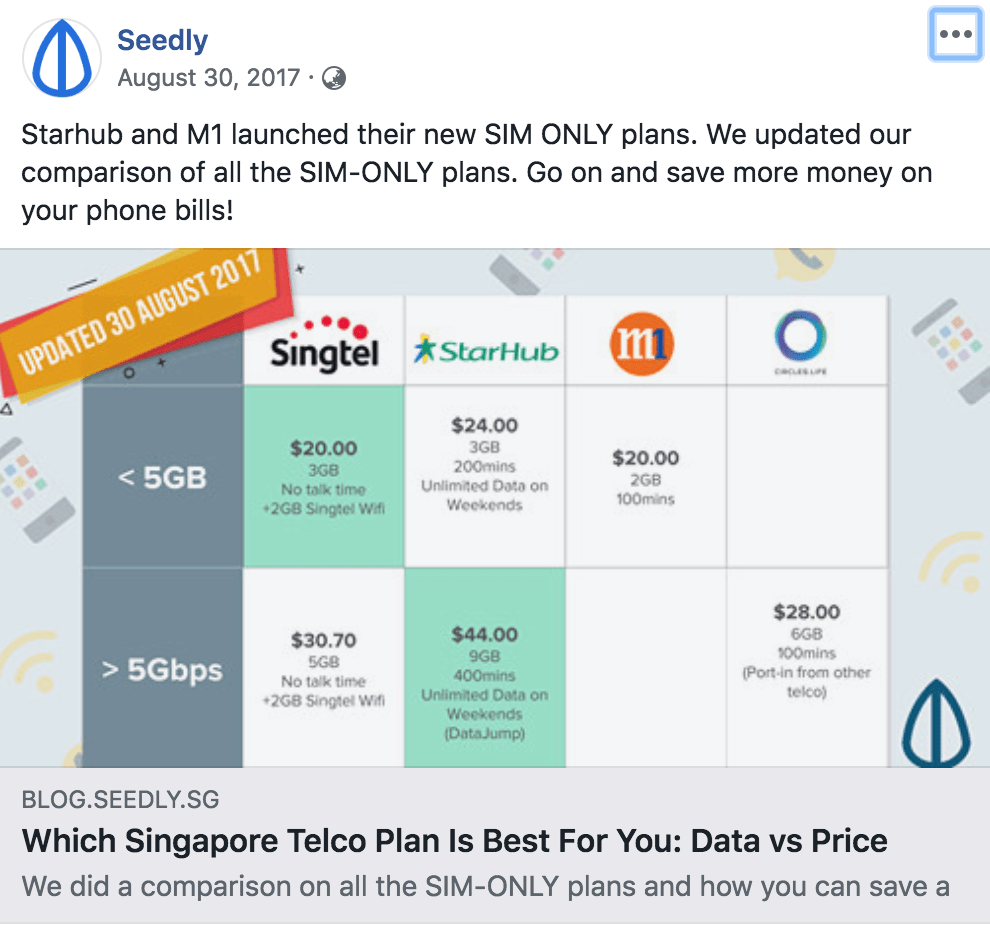There are few companies in Asia who can claim to have grown their blog from zero to 600,000 visits in just two years. Singapore-based personal finance platform Seedly is one of them, and head of content Yeap Ming Feng is the mastermind behind this meteoric rise.
600,000 visits might not seem like much, but bear in mind that when it comes to company blogs, anything in the six-figure range is a rarity in this part of the world. To build that kind of traffic to the Seedly blog in a couple of years takes something special—especially when it comprises more than 85 percent of their overall website traffic.
In this exclusive interview, Ming Feng shares how he successfully built a well-oiled content marketing system from the ground up—that focuses on their audience needs and wants—and one of the top finance blogs in Singapore.
Realizing the need for personal finance education
Today, Seedly is known for its personal finance content and community. In 2016, though, the team was focused on building a personal finance tracker app. Ming Feng joined Seedly as its fourth employee, with a mandate to get more people to install and use the app.
As such, the number of app installs per day was a key metric that he had to grow. To accomplish this, Ming Feng decided to run Facebook ads to boost the numbers.

Initially, he found a “sweet spot” by targeting people who were serving National Service. “I found out that, during the two years of serving in the army, army boys come to a realization that personal finance is really important, and they’re more than happy to download the app,” Ming Feng explains.
It also helped that it was relatively cheaper to target this particular audience as compared to working adults, he adds, as they tend to have less spending power.
Despite seeing healthy growth in the number of app installs, Ming Feng started to realize that many users were dropping off very quickly as well—many were using it for less than a month. “We realized that people were downloading the app without fully understanding the need to monitor their budgets,” he recalls. “The app installs were just not valuable to us at all […] it was basically a waste of our marketing budget.”
One particular event, where the marketing team gave away ice cream to students at the National University of Singapore (NUS) in exchange for an app download, confirmed this for Ming Feng.
“People were just there for the ice cream,” he says with a wry smile. “They were still too young to think about finance, and that was when we decided to take a step back.”
That was also when Ming Feng decided that they “needed to educate them first to prove the value of our app […] once they see that the need for financial planning, the app will then be valuable to them.”
Enter content marketing. In his words: “everything changed.”
Developing an audience focused content strategy
When Ming Feng kicked off Seedly’s content marketing plans, he made a bold move: to turn off their Facebook ads completely. “We cut our marketing budget down to zero dollars, and focused on writing content only,” he says.
Surprisingly, other than a “small dip,” the number of app installs they were seeing on a daily basis did not change much.
“As we churned out content over time, we found that as our readership went up, the app installs naturally went up as well,” Ming Feng explains. “All we needed to do was to add a little footer at the bottom of each blog post, which pointed back to the app.”
For instance: “If you’re looking at how to budget or how to save your salary, you can use this free app.”

The switch to content marketing was right in Ming Feng’s wheelhouse—he was previously a writer at another local personal finance publication called DollarsAndSense. While there, he had developed a sense of what kind of financial content Singaporeans might be interested in.
“We basically started writing about whatever we thought Singaporeans might be interested in,” Ming Feng recounts. “It was during the period when the Singapore Savings Bonds was being introduced to the market. So we decided to ride on these waves where we analyzed these popular products for locals.”
To determine what these “waves” were, Ming Feng and his team also decided to set up a Facebook group to “get a feel of what the ground was interested in.” It started out as a small audience of about 3,000 or so “friends of friends.”
Then, thanks to a resourceful member of the group, it suddenly took off:
There was this guy who took a photo of his phone bill, saying he switched to SIM only and it was way cheaper that way. The hack he shared was to buy a SIM card, and then get a phone on Carousell. This way, he saved over S$300 over two years. So we did some calculations, and published a blog post comparing all the SIM cards available in the market. Because the telcos were not actively advertising them, it made sense for us to provide this information. And the article caught fire.
As a result, traffic to the Seedly blog spiked, and Ming Feng knew that they were on to something.

“We realized that Singaporeans liked such content: lifestyle and finance hacks that can help them save money,” he explains.
From then on, the Seedly Personal Finance Community Facebook group became a lucrative source of blog post ideas.

Ming Feng and his team would observe member postings carefully to spot hot topics of interest, write them up, and then share it back to the group while crediting the original poster.

“Singaporeans love to have their names mentioned if they shared something really good for the rest of the group,” Ming Feng reveals.
It was right about this time that the team decided to switch their key metric from app installs to website sessions instead.
“Downloads just didn’t seem like a good indicator of brand loyalty, or whether our audience found our website to be trustworthy or not,” he says. “Sessions seemed to be a more suitable metric to measure how many Singaporeans know about Seedly or not.”
Distributing Seedly’s content far and wide
With a new goal to get as many website sessions as possible, Ming Feng now had to develop a system to do this sustainably.
There are certain times of the year, he explains, when traffic would slow down for personal finance blogs in general—such as in December—so they needed a system that could bring in traffic predictably, regardless of the time and month.
With the Facebook group taking off, he decided to try distributing their content on a few other channels to see which would stick.
Establishing a following on Telegram
“We tried Reddit and HardwareZone, but it’s tough to get enough points and reputation in these platforms to become influential,” Ming Feng says. “And once they found out we’re from Seedly, our posts would be removed, and we’d have to begin the process all over again.”
Then he decided to create a Telegram channel with a bot that would “blast” their content to followers on a regular basis. As it turns out, the results were far better, for far less effort.

“We had around 4000 followers, each of which would contribute an average of four website sessions per month,” Ming Feng explains. That comes up to around 16,000 sessions per month—not an insignificant amount.
Building backlinks for SEO
SEO (or search engine optimization) was, and continues to be, a major part of Seedly’s content marketing strategy. “Our SEO strength guarantees us a certain amount of traffic per month, serving as our baseline, which becomes important during the down months,” Ming Feng explains.
So while his Reddit and HardwareZone adventures did not yield much referral traffic, it did allow Ming Feng to build a good foundation of backlinks. “We also did link exchanges with partners, such as other finance blogs and fintech startups,” he adds. “They were very happy to do so, since we are all in the same space.”
He also syndicated Seedly’s blog posts on platforms such as NewsLoop, TheFinance.sg, and Singapore Investment Bloggers.

To Ming Feng, earning backlinks was “a numbers game”—at least in the early stages. After a while, however, he realized that in this case, quality trumped quantity. “It was better to get 10 backlinks from a quality website—such as the NUS website, which had an .edu domain—than a thousand from a website that wasn’t related to finance,” he explains.
Eventually, it reached a stage where Ming Feng and his team did not need to intentionally seek out backlinks any longer. “When you have a substantial number of readers, backlinks can take a backseat because the publications will begin to find your articles more frequently, and start to link back to you of their own accord,” he says.
Most of the keywords that Ming Feng targeted revolved around the names of financial products and government initiatives.
Also, salary.
“Singaporeans love to keep up with salary benchmarks,” he tells me with a knowing look. Three years on, and one of Seedly’s best performing blog post continues to be The Ultimate Salary Guide For Singaporeans.
An important part of keeping that blog post ranking for the relevant keywords, though, includes constantly updating it—month after month, year after year. “We will make sure to keep the content up-to-date with timely facts and figures, then republish it to a current date,” Ming Feng says.

He emphasizes that it’s important to have a generic slug—the descriptive section at the end of your link—that encompasses the keyword you’re targeting. For instance, /salary-guide-singapore would be ideal for the previously mentioned blog post, regardless of date.
Currently, search traffic makes up about 55 percent of Seedly’s website sessions.
While Ming Feng does keep a close eye on keywords, he points out that they are not the be-all-end-all for his team of writers. “Experienced writers are able to create interesting content with keywords in mind, but for junior writers, it restricts their creativity,” he explains.
Instead, the approach Ming Feng takes for topic ideation is far more reader-centric. The team will hold a weekly meeting where writers will present their topic ideas based on what they think Seedly’s audience would find interesting. From there, the team would vote on whether they would actually read these potential blog posts, or suggest better alternatives.
“Then I would go in to optimize the content for SEO afterward,” he says. “So it’s the other way around. I will show them how to do it, and over time they will learn how to write for SEO without compromising standards.”
Producing better content
Whether a piece of content is “good” or not is highly subjective, but most would agree that all that matters is what your target audience thinks.
With this in mind, Ming Feng experimented with topics that were quite different from regular Seedly fare during the month of December. “Most people are on holiday or on leave, and I think the last thing they want to do is to read something serious,” he explains.
So they started to produce more “lifestyle” type of content, but with a personal finance angle to them. For instance, how to travel on a budget, or how to have a Christmas feast that costs less than S$50.
This helped to mitigate some of the loss in blog traffic, making it easier for the team to jump back into their regular personal finance content when January comes by.
“Understanding the behavior of Singaporeans is very important to our content strategy,” Ming Feng affirms.
Growing a team of good content writers
Ming Feng looks back on the early days rather fondly. Back then, he and Kenneth Lou—the co-founder of Seedly—published five blog posts each per week. Today, they have a team of five writers who pen three blog posts per week instead.
However, the process of building this hit squad of personal finance writers was far from easy. Initially, Ming Feng looked out for writers who had a strong command of English, as well as a deep understanding of the financial industry.
Eventually, though, he realized that these writers weren’t very suitable candidates for the type of content they wanted to produce. “People whose financial knowledge runs deep can’t write very well, because they start writing for a very niche crowd,” Ming Feng explains. “So we realized that we needed writers who can come back down, and restart his or her finance journey with us.”

Another hurdle he had to overcome was the fact that many writers in Singapore weren’t that great at, well, writing. “I think nobody’s taught how to write properly in school,” Ming Feng laughs. “We were taught to write in a certain way that’s boring and politically correct—the academic way.”
As such, he began recruiting people who had an “okay knowledge of finance,” as well as an “okay command of English.”
His ideal candidate would also have “an eye for design,” as the Seedly team spends a good part of their content production hours on developing unique artwork for every blog post.
“Millennials take 0.7 seconds to decide if they want to click on an article, and graphics are a big part of Facebook feeds,” Ming Feng says. “So we decided to double down on this, and it seemed to work out well.”
Towards building reader loyalty in an attention-starved world
You’ve probably encountered this before: searching for a certain term on Google, and receiving ten nearly-identical results on page one.
Ming Feng is well aware of this. Seedly’s competitors have been in this space for a while now, and as such have dominated search rankings. While SEO is important to their content marketing strategy, he understands they cannot rely on it completely.
Instead, he’s dead-focused on building up reader loyalty in 2019 and beyond.

Ming Feng explains the math behind this decision: “We’re aiming to hit a million sessions by the end of the year. That means that all we need are 200,000 readers to visit our blog five times a month […] roughly once per week.”
It sounds doable, and Seedly is certainly off to a good start with its active Facebook group and Telegram channel. But Ming Feng is reluctant to put all his eggs in one basket. He points to the tweak in Facebook’s algorithm last year, which caused referral traffic to publishers to dip significantly.
“It was a wake-up call for us,” he recounts. “We realized we needed to have a diverse pool of channels to distribute our content across.”

Speaking of which, the team recently ran their very first event: the Seedly Personal Finance Festival 2019, which saw more than a thousand attendees.
“More than just being a brand, we truly want to be a community for personal finance,” Ming Feng enthuses. The fact that Seedly hosts bimonthly meetups for their community members—”just to buy them a meal and say hello”—is evidence enough of that.
It’s not rocket science
What Ming Feng finds puzzling about how companies approach content marketing today is how complicated they make it.
“I attended a talk recently where the speaker asked us, why are you thinking about Google Voice Search when your blog posts are not adhering to the latest SEO practices, or even giving readers correct information?” he tells me.
And if you’ve been reading this blog post closely (thank you!), you’ll find that Seedly’s content marketing strategy is really not that complex. It does, however, require a sincere dedication to producing good, audience focused content consistently—something that is not that easy to find in our “pay to play” advertising world.
If you’re not sure where to start, Ming Feng suggests taking a look at the publications that you enjoy reading on a daily basis—regardless of industry—and see how you can position your blog in a similar way within your industry.
“We wrote down a list of all the players who we related to, such as The Smart Local for lifestyle content and Seth Lui for food, and asked ourselves how we could be them—but for the finance sector,” he explains.
Find your angle and your crowd, Ming Feng concludes, and go after them. Who knows—your company’s blog might just become the Seedly of your industry one day.
–
Click on the slides below for a visual overview of Seedly's content marketing strategy:
—
200+ industry-leading tech companies in Southeast Asia are happy clients of With Content. Join them and start delivering valuable content to your potential customers today.



